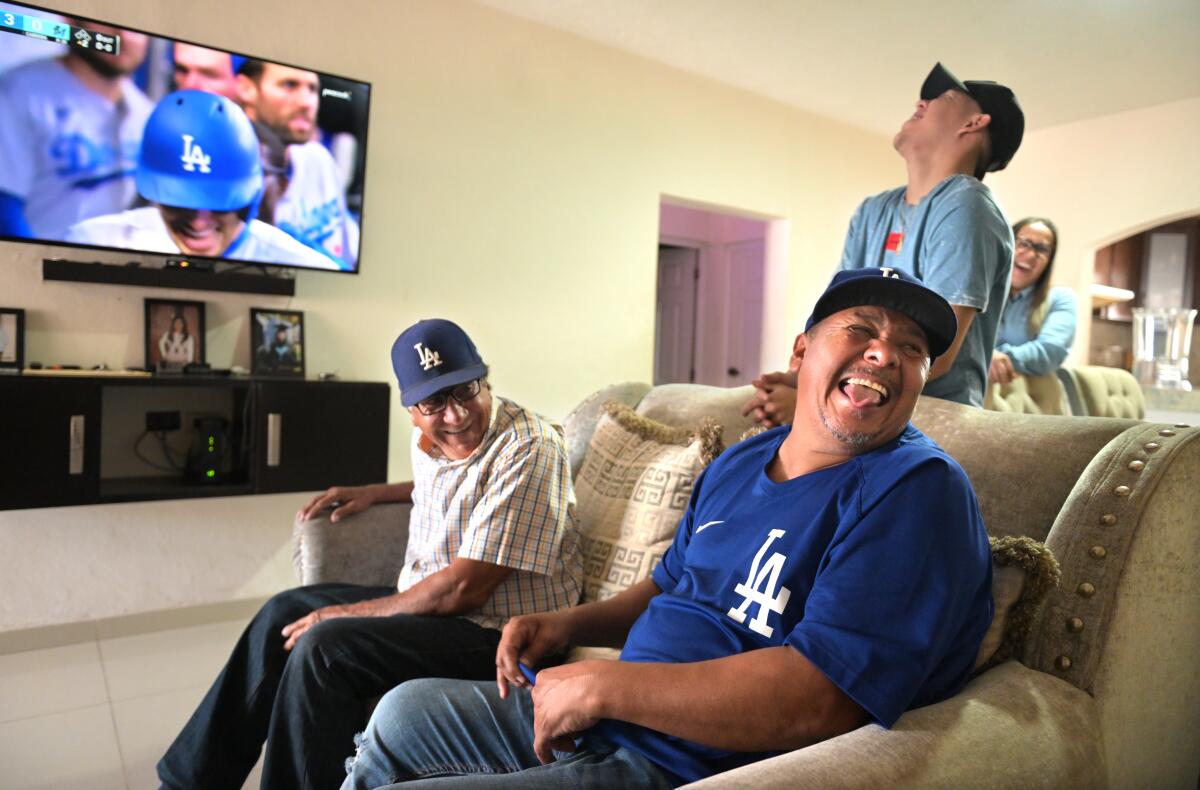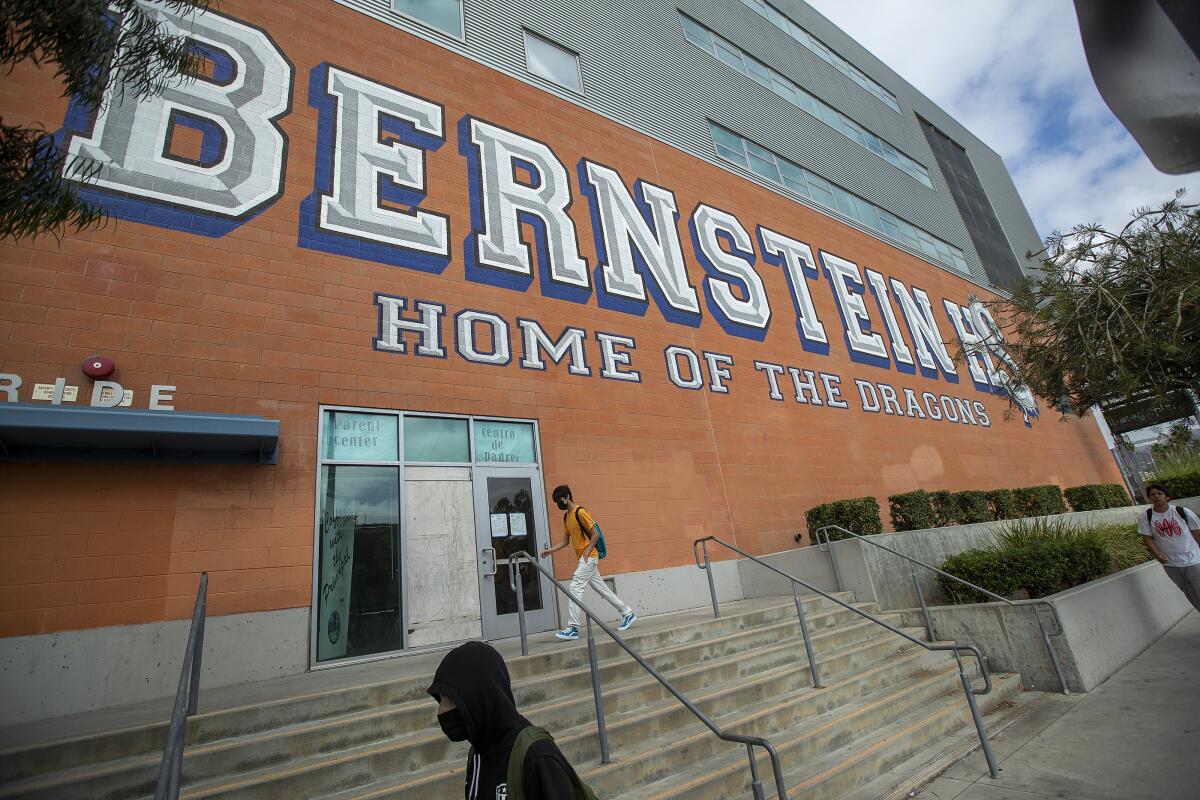Getting to know the guy with the bad left eye and the great left arm

- Share via
Good morning, and welcome to the Essential California newsletter. It’s Friday, Sept. 16. I’m Jorge Castillo, a Times Sports reporter, writing from bustling Las Vegas, where Canelo Álvarez and Gennadiy Golovkin will complete their trilogy in the boxing ring Saturday.
Up north, another Mexican superstar athlete will take center stage when Julio Urías and the Dodgers face the Giants in San Francisco.
Urías’ story is well-known in Los Angeles. He rose to prominence as a teenage phenom from infamous Culiacán, making his major league debut at 19 years old in front of the largest Mexican fanbase in the country. An eye problem, one he’s dealt with since birth, only fueled the attention. He was the boy with the bad left eye and the great left arm.
[Read “10 eye surgeries by age 10. How Julio Urías beat the odds to become the Dodgers’ ace,” in The Times.]
But the recycled stories only touched the surface. Urías has been reluctant to discuss his eye in detail. U.S.-based English-language reporters hesitated to travel to Sinaloa to examine his origins because, frankly, they thought the region to be too dangerous.
Last month, with Urías nearing the end of another standout season with the Dodgers, we set out to explore the city and his roots.
Photographer Wally Skalij and I spent a Sunday with Urías’ family, first eating breakfast at a local favorite spot before watching his recent start against the Miami Marlins in their home. By the end of the day, the house was packed with family and friends celebrating National Grandparents’ Day and another Dodgers win.
We spent the next day with Urías’ father, Carlos, who coached his son from 6 years old until he signed with the Dodgers at 16.
We ate borrego (lamb) for lunch at a neighborhood restaurant. We visited the baseball fields where Urías played youth baseball. We saw his schools. We bought horchata de coco from a family friend. We ended the day at a state-of-the-art baseball field down the street from his grandparents’ house; the governor of Sinaloa had it renovated at Urías’ request after he starred in the Dodgers’ 2020 championship season.
“I’ve been here my whole life,” Carlos Urías said, “and I’m going to die here.”
We discussed Urías’ upbringing, his dozen or so eye surgeries, his rapid ascent as a professional baseball player, his shoulder surgery, and his arrest in 2019. A few days later, I touched on those subjects with Urías at Dodger Stadium, outside the team’s clubhouse.
It’s a story on the Dodgers’ ace that hasn’t been done, one that attempts to shed a light on the famous but private pitcher.
[Read “10 eye surgeries by age 10. How Julio Urías beat the odds to become the Dodgers’ ace,” in The Times.]
And now, here’s what’s happening across California:
Note: Some of the sites we link to may limit the number of stories you can access without subscribing.

When California legalized cannabis in 2016, there was hope among some small, struggling communities. Optimism swelled that the suddenly out-of-the-shadows multibillion-dollar industry would create jobs and tax revenues to fund investments into police, parks and roads. Some cities benefited, but others saw waves of corruption, prosecutions and accusations that shook local governments. Bribery was such a concern the FBI issued a warning to Western states like California. Los Angeles Times
Weekend storms could be a mixed blessing for crews battling California’s largest wildfire As of Thursday night, the Mosquito fire had charred 67,669 acres in El Dorado and Placer counties and was 20% contained. More than 9,000 homes and structures were threatened. Officials said coming moisture could be a welcome relief, though higher winds could throw embers ahead of the blaze. Los Angeles Times
Three East San Diego County sites that included a racist trope against Native American women in their names were recently rechristened. The term “squaw” was removed from Squaw Canyon and two locales named Squaw Peak, one near Jacumba and the other outside Ocotillo Airport. They have been renamed Mat Kwa’rar Nemaaw, Mat Kwa’Kurr and Mat Puy Nah Achhuukaayp, respectively. The name change is part of an effort to rename 650 geographic features nationwide that contain the term. San Diego Union-Tribune
Check out "The Times" podcast for essential news and more
These days, waking up to current events can be, well, daunting. If you’re seeking a more balanced news diet, “The Times” podcast is for you. Gustavo Arellano, along with a diverse set of reporters from the award-winning L.A. Times newsroom, delivers the most interesting stories from the Los Angeles Times every Monday, Wednesday and Friday. Listen and subscribe wherever you get your podcasts.
POLITICS
Temecula is the latest California city to consider an abortion ban. At Tuesday’s regular City Council meeting, Councilmember Jessica Alexander proposed turning the locality in an antiabortion “sanctuary city.” “Let the world know that Temecula stands for life from womb to tomb,” Alexander said. The City Council will take up the item at a meeting next month. Los Angeles Times
Roughly 92% of 1,070 Ventura residents polled this spring directed their City Council to prioritize homeless services and projects should money become available in the budget. On Monday, the City Council amended its budget and responded to the request by adding two police officers. This action was made against advice from city staff, which questioned if Ventura could fund the additional $400,000 for law enforcement hires. Councilwoman Jeannette Sanchez-Palacios interpreted the residents’ vote as a mandate to clean up “vagrancy.” Detractors wondered why money wasn’t directed to housing services. Ventura County Star
CRIME, COURTS AND POLICING

Two high school students were arrested, one in connection with a teen’s overdose death. The two were arrested Thursday, one on suspicion of manslaughter for allegedly selling what is believed to be a fentanyl-laced pill that led to the overdose death of a student at Bernstein High School. Los Angeles Times
U.S. government attorneys suggested an eight-month term in prison for Sherry Papini of Mountain Gate. Papini captured national attention and notoriety when the FBI and local law enforcement set up a 22-day dragnet for the wife and mother who had gone missing. She later lied that she’d been kidnapped. Papini was spending time with her boyfriend. The saga, which began in 2016, will likely add a new chapter Monday when a Sacramento court decides Papini’s fate. Redding Record Searchlight
Los Angeles County Sheriff Alex Villanueva has perhaps boasted most often during his tenure about his increase in the number of people permitted to carry publicly. A Times investigation found that among those who received permits were dozens of donors to Villanueva’s campaigns and others with links to the sheriff. These people often gave questionable reasons for needing to be armed, received their permits more quickly than the average wait or were assisted by two deputies who worked directly for Villanueva. Los Angeles Times
Support our journalism
CALIFORNIA CULTURE

Ten years after writing off California Mexican cuisine as dying fad, Los Angeles Times columnist Gustavo Arellano says he was wrong. Cal Mex food, with its loud decorations, huge servings covered with cheese and its perpetual fiesta, is something Californians can embrace, he writes. Gustavo’s story is part of a package from our Food colleagues celebrating classic Mexican restaurants as a window into California’s culinary soul. The Food crew combed Los Angeles, Orange, Riverside, San Bernardino and Ventura counties for its list of 38 essential classic Mexican restaurants.
A group of residents and merchants coaxed the city of Modesto in 1990 to heavily regulate cruising on the city’s main thoroughfare, McHenry Avenue. It was alleged 5,000 cars cruised on weekends, bringing debris and leading to vandalism by drivers and spectators. Soon checkpoints and anti-loitering signs went up while fines were handed out as cruising was banned in the city perhaps best known for popularizing the activity in the 1973 film “American Graffiti.” Attitudes toward cruising have changed, however, with the California Legislature affirming the practice is part of California culture. A prominent cruising club has formed in Modesto to persuade city leaders to ditch the ban. Modesto Bee
Free online games
Get our free daily crossword puzzle, sudoku, word search and arcade games in our new game center at latimes.com/games.
Los Angeles: 82, sunny. San Diego: 75, partly cloudy. San Francisco: 68, partly cloudy. San Jose: 77, partly cloudy. Fresno: 77, sunny. Sacramento: 86, partly cloudy.
Today’s California memory is from Maurice Vidowsky:
My California memory is actually running into Brian Wilson in London. I saw him walking toward me and suddenly this 60-year-old became a teenager. The thing was that he stopped and asked, “Are you going to the show?” and even introduced me to his drummer. I was in awe, but he was so humble and real, I will always remember being a kid in my room in London and listening to “Pet Sounds” and dreaming I was in California. He was such a legend in my mind, I could not believe he was a very real person.
If you have a memory or story about the Golden State, share it with us. (Please keep your story to 100 words.)
Please let us know what we can do to make this newsletter more useful to you. Send comments to essentialcalifornia@latimes.com.
Sign up for Essential California
The most important California stories and recommendations in your inbox every morning.
You may occasionally receive promotional content from the Los Angeles Times.







